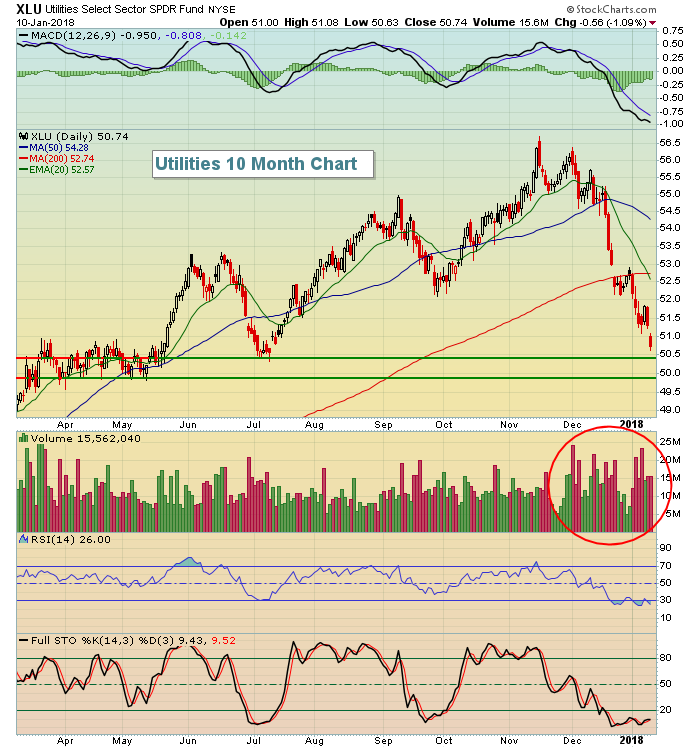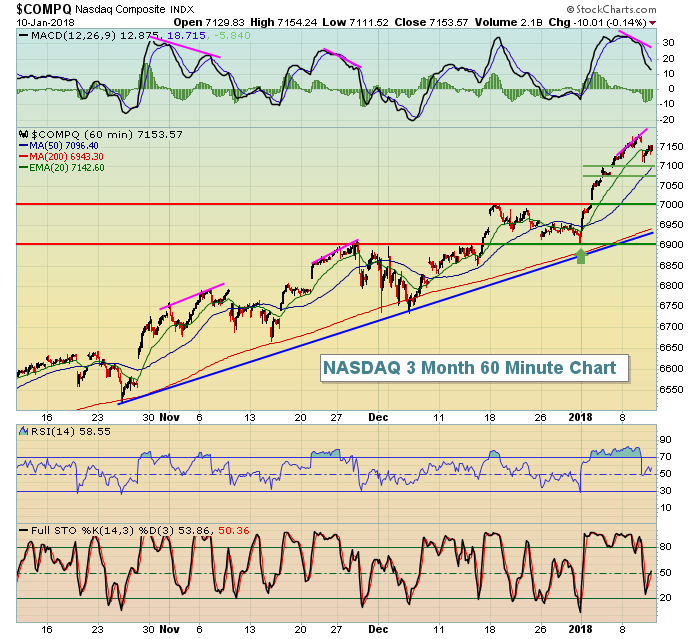Market Recap for Wednesday, January 10, 2018
We saw losses across our major indices on Wednesday, but the bulls spent most of the day recovering from steeper losses just after the opening bell. Losses were inconsequential as they ranged from 0.02% on the aggressive Russell 2000 (small caps) to a whopping (sarcasm) 0.14% on the NASDAQ. Before the market opened on Wednesday, reports were circulating that China might slow or completely halt their purchases of U.S. treasuries and that had the double effect of (1) sending traders to the exits in the bond market, with corresponding surges in yields, and (2) equity traders turning a bit more cautious as well. Typically, the stock market enjoys periods of selling in treasuries as the proceeds from such selling result in more inflows into stocks. But the reason for treasury selling does matter. Many view the China reports bearish for equities as China is widely considered a viable buyer as the Fed offloads treasuries from its bloated balance sheet. If the Fed sells treasuries and China isn't buying, there's more risk that yields could spike very quickly and that could be bad for credit availability and Corporate America's bottom line. Those early concerns appeared to fade as the day progressed.
Among sectors, financials (XLF, +0.84%) was the only sector to advance on the session and that makes perfect sense. Rising treasury yields tend to lift bank ($DJUSBK) and life insurance ($DJUSIL) shares and those were the top two industry groups in the sector on Wednesday. Utilities (XLU, -1.09%) can't seem to catch a bid and once again led all sectors to the downside. The XLU is quickly approaching a key price support level near the 50.00-50.50 area:
 That heavy volume over the past several weeks is an indication, in my view, that traders are fully expecting treasury yields to continue to rise in 2018. That's a bearish headwind for the utilities sector.
That heavy volume over the past several weeks is an indication, in my view, that traders are fully expecting treasury yields to continue to rise in 2018. That's a bearish headwind for the utilities sector.
Pre-Market Action
Crude oil ($WTIC) is approaching $64 per barrel this morning and that bodes well for energy shares now and throughout 2018. Gold ($GOLD) and the 10 year treasury yield ($TNX) are both flat this morning and we're seeing mixed markets globally.
Despite all of this, and yesterday's early weakness, Dow Jones futures are higher, up 23 points as we approach a new trading day.
Current Outlook
The 60 minute charts are beginning to show a bit of complacency as prices moved higher to start 2018. While negative divergences on an intraday chart can have little impact on the intermediate- to long-term price action, it can impact short-term price movement for a few days. I remain quite bullish U.S. equities, but a quick 0.75%-1.00% move lower on the NASDAQ shouldn't come as a shock based on the following chart:
 The top and bottom of recent gap support reside at roughly 7075 and 7100, so that area would represent a quick and visually acceptable pullback. Failure to hold the bottom of gap support, however, could lead to more short-term selling where I'd expect to see a reversal somewhere in the 6900-7000 zone. That zone includes more significant price support (recent low near 6900), trendline support at approximately 6925 and "price resistance turned support" at 7000 that resulted from the breakout in early-2018.
The top and bottom of recent gap support reside at roughly 7075 and 7100, so that area would represent a quick and visually acceptable pullback. Failure to hold the bottom of gap support, however, could lead to more short-term selling where I'd expect to see a reversal somewhere in the 6900-7000 zone. That zone includes more significant price support (recent low near 6900), trendline support at approximately 6925 and "price resistance turned support" at 7000 that resulted from the breakout in early-2018.
Sector/Industry Watch
One of my favorite industry groups for 2018 is the Dow Jones U.S. Brewers Index ($DJUSDB). They've been in an intermediate-term downtrend and it appears to be breaking. The DJUSDB gained nearly 2% yesterday and is adding to a recent runup that began 10% ago in late November 2017:
 The DJUSDB is showing very early signs of reversing its prior downtrend, including a very strong MACD centerline crossover that suggests bullish price momentum, pullbacks that hold the now-rising 20 day EMA, and an RSI that finally has broken above 70 (rarely seen during downtrends).
The DJUSDB is showing very early signs of reversing its prior downtrend, including a very strong MACD centerline crossover that suggests bullish price momentum, pullbacks that hold the now-rising 20 day EMA, and an RSI that finally has broken above 70 (rarely seen during downtrends).
Historical Tendencies
Today is January 11th and the 11th calendar day of the month has historically been the "start date" for a second wave of buying to anticipate stock market money inflows. The first wave runs from the 26th through the 6th and the second wave runs from the 11th through the 18th. Here are the S&P 500's annualized returns (since 1950) for each calendar day during this upcoming bullish period:
11th: +12.11%
12th: +9.99%
13th: +9.46%
14th: +5.19%
15th: +9.81%
16th: +33.75%
17th: +12.99%
18th: +17.21%
The 11th through 15th period follows the S&P 500's average annual return of roughly 9%, but as new money hits the market to begin the second half of the month, annualized returns spike. This is another signal that supports the likelihood of further gains next week.
Key Earnings Reports
DAL: .96 vs .88
SJR: .19 vs .25
Key Economic Reports
Initial jobless claims released at 8:30am EST: 261,000 (actual) vs. 245,000 (estimate)
December PPI released at 8:30am EST: -0.1% (actual) vs. +0.2% (estimate)
December Core PPI released at 8:30am EST: -0.1% (actual) vs. +0.2% (estimate)
Happy trading!
Tom
